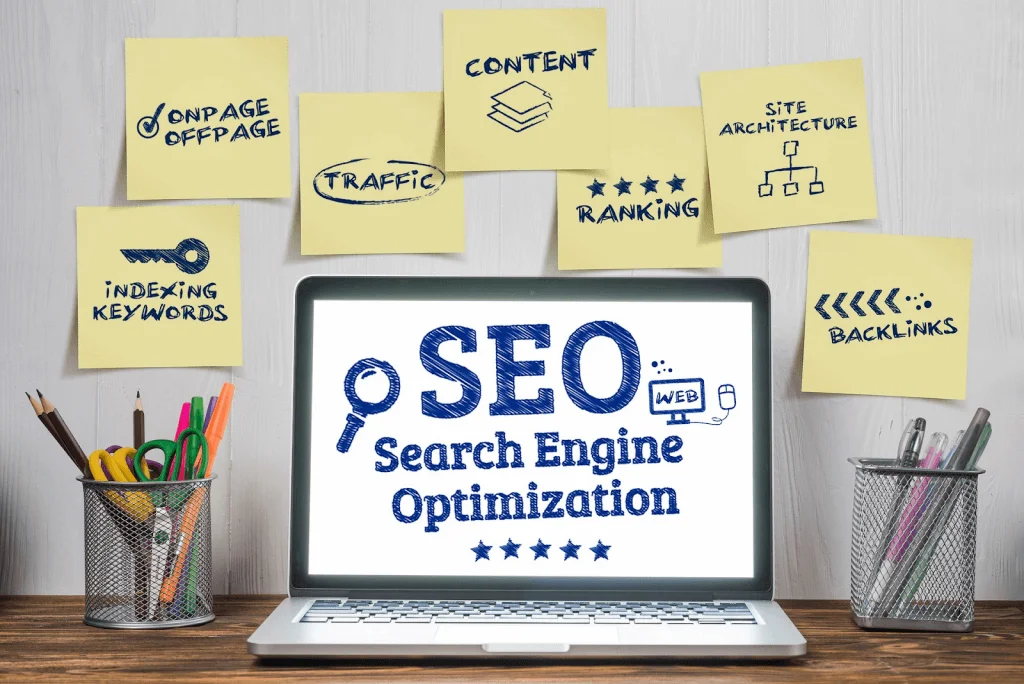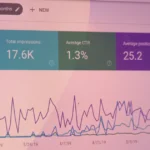SEO implementation is not rocket science. However, for either developing a new website or working on an existing eCommerce website, it is very important to follow specific steps or rules suggested by website developer experts for SEO improvements to generate website visitors.
SEO is concerned with enhancing your website’s traffic and visibility by implementing the best UX practices. How can I use WebFrame to rank websites? Let’s talk about this and other concerns.
You go to your browser’s search page and ask a question. Anything question from “Any dessert recipes” to “How to develop a website” could be. Google will generate dozens of pages of search results for any inquiry or search terms you type.
So, what must I do if I would like to be to come on the first page of SERP? Search Engine Optimization plays its role here.
What Is Webflow?
Webflow is a cloud-based content management system (CMS) for web publications. Webflow is ideal for the majority of websites, for reducing maintenance and increasing performance. Webflow editorial staff gives designers an easy-to-use interface for building outstanding websites. Having a graphic designer and freedom in a website could perhaps let you create something truly distinctive.
The process of adapting your blog content as well as layout to suit the dimensions of the screen/device it supports is known as responsive web design. It is essential to consider it for practicing good SEO, especially for mobile devices
Why Choose Webflow?
Webflow has a lot of useful templates and allows you to create beautiful websites without writing code. However, you have to play around with it to see if this works out for you.
Webflow gives you some helpful guides that you can follow, and once you begin to drag and drop things at the end, the editing process becomes a lot simpler. In recent years responsive websites have changed the way we build web websites drastically. It has become harder to design websites now, but it’d still be complicated and costly.
Is Webflow SEO-Friendly?
Yes, it is. Webflow provides you with all the resources that are required to improve your SEO. There are several essential SEO considerations for your Webflow website, which we will discuss in this article.
Webflow does not require programming, and it is no different. However, since WebFlow does not support plugins, coding abilities would be helpful. Webflow provides integrated SEO capabilities such as automated title tags and description creations, robots.txt update to sitemap, strong URL redirect, and 301 redirect capabilities.

What makes Webflow so attractive for many people is its simpler code and fewer storage requirements. Even though the platform requires more specialized web design skills than others, it is a highly customizable CMS offering attractive interfaces.
What Is SEO?
The technique which is used to improve the ranking of your website on a search engine results page (SERP) to obtain more visitors is known as search engine optimization (SEO). The goal is to appear on the top page of Google results for the search phrases that are most important to your targeted audience.
SEO recommended practices must be considered independently of how your website is designed. Each site on every web page is crawled by a bot crawler, which then uploads the results to the indexes web page.
The algorithms would scan certain websites for specified phrases in the background to guarantee you are receiving the best possible result for your search. Let’s discuss different approaches to implementing SEO on Webflow.
Technical SEO In Webflow
Technical SEO relates to website and system optimizations that aid search engine crawlers in more effectively analyzing and indexing your site. Check below for the main steps to optimize your Webflow technical SEO.
- Structure your data with schema markup
- Pages load quickly
- Describe images, alt tags, and file names
- Use sluggish loading techniques.
- Improve the CSS
- Send an XML sitemap
- Don’t let Google index your webflow.io subdomain
- Build an intuitive site hierarchy
- Use mobile-friendly design
- Maintain your robots.txt file
- Learn tools that help with SEO
1- Structure Your Data With Schema Markup
Schematic Markups in Webflow are data and metadata definition codes. It aids search engines in determining the quality of the data. These details may be found as rich snippets in SERPs, and their content is essential for SEO. They sometimes show related searches option to retain their viewers.
2- Webflow Helps To Load Pages Quickly
Nothing is more irritating than waiting several minutes for a website to load. The most significant SEO issue for a website is a slow load time which is improved if you choose Webflow builder for you. These procedures can also be used to improve the speed of a website. There are many ways to improve your site’s speed, including:
- Image shrinking or compression
- Data caching (Java, CSS, HTML)
- Only utilizing images, animations, and site elements as needed
“Have you experienced the frustration of a software bug firsthand? They can potentially lead to a complete system crash down.
Read More: How to reduce bugs in software.”
3- Describe Images, Alt Tags, and File Names
Multimedia can help increase the number and quality of audience engagements of your site, but make sure to optimize those with Webflow easy tools for search too. Since crawlers are unable to read images, they must understand what each image contributes to the page. Using alt text, that describes your image’s code, can help improve SEO.
Originally the Alt text is written to be readable by screen readers and to aid the visually impaired. However, search engines will understand it if you use it in a specific context. You can also improve Search Engine Optimization if you give a description of a website.
4- Use Sluggish Loading Techniques
Whenever lazy loading is allowed, a browser would only load pictures and items at the peak of the Webflow webpage first, then followed by contents further down the page. This offers the user impression of a completely loaded page, which increases retention and shows good UX and UI practices.
5- Webflow Improves the CSS
You can fix several typical inconsistencies if you know the Webflow CSS tool (the coding responsible for styling pages). Whenever loading a website, you may dramatically minimize the number of queries by using inline CSS and consolidating files.
“Do you know? The ultimate purpose of the SDLC 5 Phases is to improve the regularity, efficiency, and general quality of informational technologies or software development methods. Read More: SDLC 5 Phases and types of SDLC.”
6- Send an XML Sitemap
Internal linking is required in most cases for a crawler to look at your site, although some may find it too difficult. When this happens, your website gets removed from search results. The XML sitemap in this scenario of the Webflow guides search engines on all of the content they’re seeking to crawl through.
This is an example of an XML sitemap. Webflow generates the XML sitemap promptly, which saves your time. You can also personalize your sitemaps to your liking.
7- Don’t Let Google Index Your Webflow.io Subdomain
Content management software includes a virtual environment where developers practice software design and get previews. The Webflow version is a duplicate of your website hosted on Webflow’s domain.com.
A developer can construct a fresh iteration of a website without changing the primary version by using the URL—Google’s webflow.io. The website is hidden from Google searches and will be ignored or indexed without warning. For your Webflow subdomain, deactivate subdomain indexing. It’s less probable that any duplicate will affect your rankings.
8- Build an Intuitive Site Hierarchy
A website structure explains how vital a topic is on the website for which Webflow helps to think out of the box. Building the website structure is similar to the outline of a dissertation. Issues are categorized according to their importance for your overall web design purpose.
By organizing content, search engines will see how your site operates. A good website hierarchy needs to be relatively thin, and there shouldn’t be more than one topic in the order and no subtopic. Thinking in this manner when planning for a website will help design a content package that fits well with your prominent brand.
9- Use Mobile-Friendly Design
Google uses a mobile-friendly indexing approach. Google will index your mobile website if it does not appear in a search. Webflow enables responsiveness, which allows for such indexing.
A responsive design modifies web pages dynamically according to the visitors’ devices and VPN settings. This enables you to rapidly create a page that is mobile-friendly and readily searchable.
10- Maintain Your Robots.txt File
Robot.txt files are crawlers for search engines. The maintenance of these files ensures that the best information on a website is accounted for in search engine results. This feature of Webflow might be used to alter the material, create new content, and hide irrelevant stuff. A poorly designed website is likely to have a detrimental impact on SEO.
11- Learn Tools That Help With Webflow SEO
Even though Webflow CMS does not support plugin installation, the SEO Toolkit is available.
Tutorial instructions, keyword databases, or a search engine are examples of these. Without using tools SEO can be complicated. Google provides free tools like Google Search Console (GSC) to verify indexing status, crawling issues, search queries, and optimize their websites’ exposure. Moreover, the following are some prominent SEO brands and tools recommended by professionals for the Webflow website:
• Ahrefs
• Moz
• Bing Webmaster Tools
• Google Search Console
• Google Analytics
On-page SEO
This is a technique for increasing Webflow website traffic. This includes things like title and header tags, internal links, and maps, which are visible to visitors. One of the most extensively utilized and accessible SEO tactics is on-page SEO.
As your site receives more visitors, using online search optimization will improve your online exposure by raising your page rank in the SERPs. Let’s take a look at some on-page SEO strategies which can easily be managed through your Webflow Website.
- Use keyword research for specific web pages
- Publish valuable content
- Identify duplicate material
- Optimize your URL, meta title, and meta description
- Put Your Most Important Pages Up Top
- Make an Editorial Schedule
1- Use Keyword Research For Specific Web Pages
It is only an initial stage. When trying to get traffic for certain websites, you should research keywords. Put yourself in the shoes of a person looking at a particular issue. This is precisely the text you want in the text editor for the webpage.
How to Do Keyword Research?
- Based on the expertise of your company, create a list of significant, relevant topics.
- Add keywords of relevant topics.
- Search terms for relevant research.
- Take advantage of keyword research tools.
2- Publish Valuable Content
Keyword research can be the key to creating a quality website. It shows how much a customer is seeking. Once you know those, you can write content that meets the requirements. However, you will need to learn the various search intents to achieve it correctly.

Good content has an efficient structure. Use headings for organizing related content or category on a Webflow website. So users can read and digest your content quicker, and search engines will rank in a more efficient manner. Finally, keep an eye on your external links. Crawlers search your pages using internal links.
By implementing a social media marketing strategy, you can grow organic traffic for your content, particularly if you’re new to SEO Webflow CMS.
“Do you know? Website maintenance services assist you in naturally ranking better on search engine results pages. Learn More: What is a Website maintenance services list?”
3- Identify Duplicate Material
Search engines have a hard time detecting duplicate material in search results. Indexing a website with many URLs and the same content is complex. To solve this problem, add an appropriate tag to your actual page for a particular query. It will aid you in lowering Google’s ranking and is suitable for SEO strategy.
4- Optimize Your URL, Meta Title, and Meta Description With Webflow Tools
The information on your webpage on the search engine results page is the first impression that users have of your site. Ensure that these pages accurately convey the value of the website.
A meta title should contain a description relevant to the terms you want for keywords. Good meta descriptions must include information unique to a page.
Try to have it under 60 characters; otherwise, the title gets removed from SERPs. Having the title on a website should explain how the content on that page is unique and relevant, making it easy to find.
It is vital to keep your target keywords/keyphrases in mind when writing. It is simple and quick for search engine optimization to add your target words to every possible place and stay relevant.
It can be much harder to optimize after writing a text. This may be because your target keyword doesn’t correspond to the content of your page. Although there’s no harm in doing that, it just doesn’t work well in many cases.
“14 Tips to choose an expert and reliable web design company. Read More: How To Choose a Web Design Company.”
5- Optimize Your Most Important Webflow Websites Pages.
Google will find that the top pages on which you should be ranking the most, is your website. Can you list all the page types? Is this page the root page of my website?
The most crucial elements that make up the framework of your Webflow website are the core pages, such as the home page, contact page, price page, services page, about page, etc. The optimization of such pages should be the initial step in your on-page SEO strategy.
You might start by making a list of the keywords that best define your company. Based on the keyword and competitor information from the preceding phases, do this. Then, start incorporating these keywords into the main sections of your website.
When it comes to optimizing top pages, looking at competitors who are ranking for certain target terms is a great place to start. During reviewing competitors’ content some questions strikes my mind—What strategies are your rivals employing? What are the subjects they discuss in their content?
- Put Attracting Themes
Ensure that your page covers themes according to content types. You should aim to provide your users with the most acceptable potential structure as well as user experience. This is important in terms of the SEO perspective.
Then start incorporating keywords into your article. Make sure your targeted keywords appear in your webpage title, headers, and body material. You can boost your possibility of competing for many phrases by providing keyword variations.
6- Make an Editorial Schedule
Keeping your webpage up to date and adding new, informative keywords to your portfolios requires creating and managing an editorial calendar. Create a content strategy to target informative keywords linked to your goods and/or services on a regular basis. This will enable you to keep adding quality to your domain, connect to commercial pages within, and attract fresh visitors to your site.
You can deliver great material to your viewers and get new prospects into your sales pipeline with active blogging that is backed by keyword analytics. To outrank your competitors, remember to employ on-page optimization and in-depth, rich content.
“Do you Know? Measuring user experience is an important stage in establishing a long-term business ’ products. Read More: 18 Tools to Measure, Quantify and Optimize the User Experience in 2022”
Off-Page SEO Strategy
All SEO strategies that do not include updating or posting material to your website are referred to as off-page SEO. Off-page SEO simply informs Google about what other people think of your website. If you have a lot of excellent links going to your sites, for instance, search engines will think you have valuable information that users find useful.
Any SEO technique that you use on other websites is considered on-page SEO. These areas help establish industry brand credibility. Off-Page SEO reflects one goal: getting a link for your website. The reason for this success is a technique called “link building.”
Why Is It Vital To Develop Links?
The activity of obtaining ‘backlinks’ from other websites that point to your website is known as link development. A backlink is a link from another website to your own. A link may be thought of as a word of confidence from one website to another. Search utilizes links as indicators to determine a website’s relevancy and authority.
Backlinking is an excellent way for SEO because it builds trust from both users and crawlers. When another website views a site linked to another site, you get a vote. It tells Google that it’s crucial for your website that someone should see it.

The quantity and value of links pointing to your site are both important ranking criteria. All hyperlinks are not made equal. A hyperlink from a well-known website for instance, BBC, would be more valuable than a link from a tiny local business. If your rivals have more links or connections from higher-quality resources, they will outperform you.
Explaining Authority Metrics
The reliability and potency of a website’s backlink profile are measured using authoritative metrics. The algorithm now includes Google’s proprietary authority measurements, which are no longer visible to the public.
Instead, SEOs assess a site’s authority using measures like Moz’s Domain Authority (DA) or Ahrefs’ Domain Rating (DR). In other words, the greater your reliability metrics, the greater your ranks. You must generate links with rising and relevant websites to boost your authority.
Steps To Establish Best and Advanced Webflow SEO Practices
1- 301 Redirect For The Win
The good thing about the Webflow website is that there are no fixed or static web pages. It is possible to continuously improve website design, content, and architecture for a better user experience. But there is an inconvenience: When a page has a different structure, you can simply delete it and remove it from the site.
Unfortunately, there is a redirect to 301. When you delete an entire web page, redirect the old URL to another website that has an identical (but hopefully better-suited) site. If your website is moving from another location or has a different URL, create redirections to that new place.
2- Use Webflow–Alt Tag
Alt tags are incredibly helpful and overlooked HTML elements. Forgotten because they are usually hidden from web developers, but incredibly valuable because you have to add descriptive alt on the images. Moreover, this feature of Webflow makes the images so clear and descriptive that people with visual impairment could see them. And use keywords, if necessary.
Earlier in the year, people used tags to find 50 words to rank at a place most users never looked up in search engine results. Google quickly learned of this, penalizing your pictures for using keywords. Is there any other way to make a keyword a contextual and non-spam keyword?
3- Structure Your Data With Schema Markup
Schematic Markups are data and metadata definition codes. It aids search engines in determining the quality of the data. These details may be found as rich snippets in SERPs, and their content is crucial for SEO.
4- Build a Helpful 404 Page
It’s not easy to create 404 pages with Webflow. Create 404 Pages and give them URLs ending in /404.
404 pages offer unique opportunities to help ease pain from hitting a broken link. When people come across your 404 sites it’s likely to cause some frustration for them.
Indeed they clicked it to see what you told them, and they wanted to learn something there. And several websites try to minimize that annoyance through humor – something we like and enjoy a little in this business—I would suggest you avoid or just stay very mild.
5- Subdomain Responsibly
I hate breaking it up with you, but Google has found that your domain has an entirely different name from your root domain. The technology offers advantages and disadvantages, so there are no excuses for a user to stop using Sub-domains. It simply signifies you’ll have to do it in a conscious way.
Know that this subdomain does not have any direct impact on your core site’s SEO. And it’s possible for people to use your site by clicking links on your subdomain website. This subdomain should be useful, entertaining, shareable, and even include links throughout to a core webpage.
6- Work That Sitemap
If your company is using Webflow, it will automatically create XML sitemaps to support your website SEO. An XML website map allows Google spiders to see where your web page is and helps guide them to what pages you want.
You have a website mapping tool, and you have many options for doing everything, but the key function is for Google to see if a page has a well-linked external website. It also provides information on how often page changes are made and how the page resembles other websites. Remember that the importance of a ranking is not particularly important.
7- Research Keywords and Write “SERP-in” Content
When looking for high-ranking keywords for a website, you should be thinking about specific terms. Before putting your first words on the paper, make sure the keywords you use are relevant to your business. Obviously, the term “search keywords” could sound a bit overwhelming and even costly. It is easy to use keywords in some ways that will generate exciting topics for your blog post.
8- Use Google Trends
Google Trends help us decide what content should be prioritized. It’s also been observed that phrases can be difficult to rank at times, if at the least in an abstract way. The terms “responsive websites” (blue lines for short) are the most widely used and are therefore difficult to list.
9- Use Google AdWords Keyword Planner
Well, most of your SEO efforts will not take place immediately, Google’s Keyword Planner can help you prioritize your keyword research. I know that I will be competing with other searchers for a particular word based on the keyword that I’ve chosen.
I’d probably want to target the most specific search term and not have a lot of competitors for this. Many SEO tools will give you an estimated amount of authority that Google has over a specific topic.
10- Now Start Writing SERP-in Content
Now we have a topic. Next, it’s time for some serious writing, film, or podcast. It’s a very important job to make certain your content is focused in a timely way. What information does a better job of identifying and addressing specific topics? Use Google’s Search Suggestions. It’s easy to find ideas for content using the SERP.
Steps To Gain Recognition On Google—SEO for Webflow?
Making your site appear good is very important, but Google doesn’t necessarily rank you as high as other sites. This is why you need SEO. It involves several steps to gain recognition on Google.
1- Having Correct Heading Structure
You have to make a website structure that supports an H1 – H6 format. Heading 1 (H1) is the heading that is in the center of every page on your website. Google searches first for your H1 to see what pages are available.
You should have an H-1 for all the websites because combining them, confuses readers & search engines. Why should my website have multiple headings? H2-H6 are to show Google how the subheadings are for your content.
“Do you know? The most important part of the software development process is compiling, which translates source code files into executable code. Read More: What is software building process?”
2- Automatically Generate Sitemaps
You can create an online map using Google ‘SEO’ settings and simply click ‘YES’. Using e-mails or other software, a website map helps Google find your website and help you improve the search results.
A website map also contains metadata to determine if a website was updated or not. Google sees your entire content and understands its structure, which is crucial for SEO. Webflow creates sitemaps automatically, making your work easier.
3- Clear Navigation Structure
This may happen by having the tabs above your site or by enabling the drop-down menu to appear easily. Also, ensure your page footer has a clear layout to facilitate navigation. The link to your website can also be linked to other pages on the page.
For your email, use the text link on the email address. For instance, Use a hypertext linking to your contact page when your text states, “contact us for additional information.“
Why Is Navigation Structure Important For SEO and UX?
A clear navigational menu and footer will be helpful when Google searches the page for your specific pages. That would hopefully make Google see every page on the site. Clearer navigation helps people to reach the desired page or position. Many people don’t enjoy putting up with 10-minute searches on their company’s website.
4- Change Your Webflow Settings
Webflow offers automatic search engine optimization. The settings menu is labeled “Hosting”. Ensure the 4 initial settings are turned ON. The last was “on.” For more updated information you can reach us.
5- Use Google Analytics On Webflow Website
Once a website is created, Google Analytics is installed. The information you gain from the site will help you understand more of it. The analytics page shows the websites that most people visit. You can determine if they view one page and leave it or if they are going through a number of different sites.
Besides demographic details, it is possible to see how your visitor is based on age or geography. Give a bit more time to develop and test your websites for SEO if you want a good ranking on SERP.
Best Webflow Developer In the USA
Site builders abound on the market promise to be universal answers for every design problem. However, they often fail in both design and development aspects. Hire Webflow’s website designers and developers to construct a professional, mobile-friendly website that meets your requirements.
Hapy takes care of the burden of generating and repairing them by providing high-quality work with award-winning team members for a fixed monthly cost, allowing you to focus on what you do best.
With Hapy, you’ll always have an open line of communication via client tools to communicate and keep track of your project’s development.
Final Thoughts
Following the practices or rules outlined above may take some time, but it will ensure that you are on the right track.
The most significant aspect of SEO, whether it’s on Webflow or elsewhere, is to fulfill the user’s interest. Create content that offers the users practical, relevant, and valuable information.
This, together with the responses to the previous questions about all SEO practices will help you achieve organic ranking success.
So, go to work. Better rankings are on their way!
Share your queries with us for a better and more successful plan.
FAQs
Why are these Webflow SEO settings necessary?
This setting will immediately boost website performance. This promptly decreases load time and bandwidth consumption. This results in faster website speed and accessibility and creates a more useful user experience for users on your website.
People find slow website loading frustrating, and a maximum of one-second speed is recommended. If this happens, the user will stop and move on to better-performing sites.
Why is heading structure important for SEO?
The header structure is important for search engines and readers. Among the best features, the H1 can be included on the page and enhances the searcher’s relevance for key keywords. The heading also attracts the reader to its content. Like if you’re reading the newspapers, you’re going over the headlines to find the ones you enjoy most.
Why are title tags and meta descriptions important for SEO?
They will appear immediately when someone searches on Google. Title tags and meta descriptions are used by people to determine whether they want to use your website or not. Be cautious for title descriptions or meta descriptions because Google isn’t interested in duplicates.




